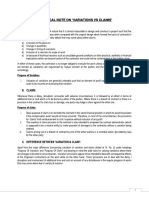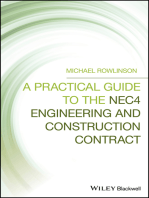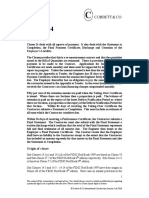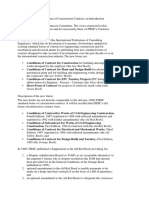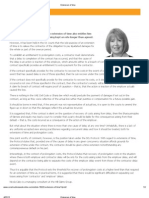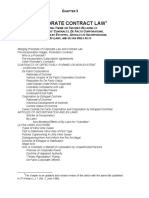A Practical Guide To The 1999 Red & Yellow Books, Clause8-Commencement, Delays & Suspension
A Practical Guide To The 1999 Red & Yellow Books, Clause8-Commencement, Delays & Suspension
Uploaded by
tab77zCopyright:
Available Formats
A Practical Guide To The 1999 Red & Yellow Books, Clause8-Commencement, Delays & Suspension
A Practical Guide To The 1999 Red & Yellow Books, Clause8-Commencement, Delays & Suspension
Uploaded by
tab77zOriginal Description:
Original Title
Copyright
Available Formats
Share this document
Did you find this document useful?
Is this content inappropriate?
Copyright:
Available Formats
A Practical Guide To The 1999 Red & Yellow Books, Clause8-Commencement, Delays & Suspension
A Practical Guide To The 1999 Red & Yellow Books, Clause8-Commencement, Delays & Suspension
Uploaded by
tab77zCopyright:
Available Formats
FIDIC users' guide: A practicnl guide to the 1999
Red nnd Yellow Books
work in advance of the programme should be agreed with the Engineer.
Any such advance working might also be highlighted in the monthly
progress report.
The Contractor is required to give notice to the Engineer of any events
or circumstances that may adversely affect the work, increase the
Contract Price or delay the execution of the Works. This requirement
for a notice from the Contractor covers virtually anything that has an
adverse effect on the activities of the Contractor and not just matters
that affect the programme or for which the Contractor intends to
submit a claim. It is in addition to the requirement for claims notices
under Sub-Clause 20.1 although a delay or price situation will frequently
result in notices under both clauses. The Sub-Clause 8.3 notice must be
given 'promptly', which is much quicker than the 'not later than 28
days' requirement for the Sub-Clause 20.1 notice. Flowever, this notice
appears to serve the same purpose as the potential delay notices under
other Clauses, such as the delayed drawing or instruction notice under
Sub-Clause 1.9 (RB).
The Sub-Clause 8.3 notice is
in effect an 'early warning notice' and
gives the Engineer the opportunity to take action to overcome the
problem before the Contractor incurs delay or additional cost. There is
no requirement for the Contractor to meet with the Engineer to discuss
the problems and possible solutions, but the Sub-Clause does enable
the Engineer to require the Contractor to submit estimates and proposals.
For good management the Engineer would normally meet with the
Contractor to discuss the potential problem and the best way to overcome
the problem.
8.4
Exlension of Time for Completion
The Controctor sholl be entitled subiect to Sub-Clouse 20.1 [Conlroclor's
C/oims] to on extension of the Time for Completion if ond to the extent
thot completion for the purposes of Sub-Clouse l0.l [Toking Over of
lhe Works ond Seclions] is or will be deloyed by ony of the following
COUSES
(o)
o Voriolion (unless on odiustment to the Time for Completon hos been
ogreed under Sub-Clouse 13.3 [Voriolion Procedure]) or oiher
substontiol chonge n the quontity of on item of work included in the
Controct;
(b) o couse of deloy
(.)
(d)
180
giving on enlitlement to exlension of time under o
Sub-Clouse of these Condilions;
exceptionolly odverse climotic conditions;
Unforeseeoble shoroges in the ovoilobility of personnel or Goods
coused by epidemic or governmentol octions; or
Clnuse 8: Conu'nencement, Delnys and Suspension
gineer.
(")
ronthly
ony deloy, impediment or prevention coused by or oltributoble to
the Employer, the Employer's Personnel, or the Employer's other
controctors on the Sile.
events
,se the
rement
has an
natters
nds to
notices
uently
rust be
han 28
no
under
under
:e' and
ne
the
here is
liscuss
enable
posals.
ith
the
Srcome
roctor's
I extent
lf the Controctor considers himself to be eniitled to on extension of the
Time for Completion, the Controctor sholl give notice to the Engineer in
occordonce with Sub-Clouse
20.
[Coniroclor's C/oims]. When deter-
mining eoch extension of time under Sub-Cfquse 20. , the Engineer sholl
review previous determinotions ond moy increose, but sholl not decreose,
fhe totol extension of time.
In the Yellow Book the reference to a 'change in the quantity' in
paragraph (a) is not relevant and has been omitted. Sub-Clause 8.4 lists
the situations which may entitle the contractor to an extension of the
Time for Completion. It is not sufficient for the event to cause delay or
disruption to the Contractor's work; the Contractor must demonstrate
that it will actually delay completion under Sub-Clause 10.1. The
Contractor must comply with the notice and other requirements of
Sub-Clause 20.1, which means that the Engineer will then follow the
procedures of Sub-Clause 3.5 in order to determine any extension of
time.
Sub-Clause 3.5 does not give the Engineer a time period for making
this determination although it must not be 'unreasonably withheld or
delayed' under Sub-Clause 1.3. Any determination of an extension of
time should be made quickly in order that the Contractor can revise his
programme to suit any revision to the Date for Completion or can
accelerate to meet the previous Date for Completion. If the determination
is delayed then the Contractor might have a claim for the Costs of an
acceleration which is not then necessary or the additional Costs or
delay caused by the late determination.
Sub-Clause 8.4 only entitles the Contractor to an extension
llor,
of time,
which brings relief irom delay damages under Sub-Clause B.T, but
not to additional payment. Where there is an overlap with another
Sub-Clause the Contractor will generally submit his claim under the
Sub-Clause which also allows for additional payment, in addition to the
rs been
relevant paragraph of this Sub-Clause.
The matters listed are as follows.
)ver of
r other
i in the
;nder o
Goods
(u)
Varations. Clause 13 gives the Engineer the power to issue instructions to vary the Works and the Engineer may ask for a proposal
from the Contractor before issuing the instruction. If the Engineer
has not asked for such a proposal then the Contractor must give
notices promptly under Sub-Clause 8.3 and within 28 days
under Sub-Clause 20.1 1f he considers that the Variation may
delay completion. The Contractor may also claim an extension of
L81
FIDIC users' guide: A practical guide to the 1999 Red nnd Yellow Books
time if there is a substantial change in the quantity of an item of
wor which would presumably occur as a consequence of the
(b)
measurement procedure under Clause 12.
Other Sub-Cluses. The other Sub-Clauses which entitle the Contractor to an extension of time are discussed under the relevant
Sub-Clause:
1.9
2.1,
4.7
4.12
4.24
7.4
Delayed Drawings or Instructions
Right of Access to the Site
Setting Out
Unforeseeable Physical Conditions
Fossils
Testing
10.3 Interference with Tests on Completion
73.7 Adjustments for Changes in Legislation
(")
1,6.1, Contractor's Entitlement to Suspend Work
77.4 Consequences of Employer's Risks
19.4 Consequences of Force Majeure.
Climatic conditions. To justify an extension of time the Contractor
must demonstrate that the climatic conditions were exceptionally
adverse and actually delayed completion. It will be necessary to
submit records for the normal weather over a period of, say, five
years. The Employer may already have such records and made
them available at Tender stage under Sub-Clause 4.10 or the
Contractor should have obtained all available information under
Sub-Clause 4.10(b). In order to record the actual conditions, it
will be necessary for the Contractor to have the necessary equip-
ment in place from the start of the project, such that rainfall or
other conditions are recorded automatically when they occur,
even though such conditions may occur outside normal working
hours. Claims for climatic conditions will only result in additional
time, but not money, and they are specifically excluded from
the unforeseeable physical conditions situations under Sub-
(d)
(")
Engine
(c) ren
clarifie
referer
Patagr
omitte,
too ger
be nol
entitle,
for clai
with tl
and th
cover
toan
8.5
lf th
(o)
(b)
(.)
lher
sub
This
extens
Clause 4.12.
requrr
of personnel or Goods. The shortage must have been
unforeseeable by an experienced Contractor, as defined at SubClause 1.7.6.8. and caused by epidemic or governmental action.
Governmental action is not restricted to the government of the
Country of the project.
order
Shortages
SlONS
The
Counl
trend
Employer causes.If the Employer causes a delay then the Contrac-
tor, as the other Party to the Contract, should be entitled to
compensation. Part (e) gives an overall right to an extension of
time but many of the events which are covered will also be
covered under Employer's Risks as Sub-Clauses 17.3 and 17.4.
The reference to the Employer's other Contractors on the Site
182
Byc
previor
B.(
lf, ,
(o)
Clause 8: Commencenrcnt, Delays and Suspension
must be read in conjunction with Sub-Clause 4.6, which refers to
the reimbursement of cost, but not delays.
.tem of
of the
e Con:levant
rtractor
ionally
sary to
ry, five
I made
or
the
under
ions, it
.
equrp-
rfall or
occur/
'orking
litional
I from
r S'''
been
at Subaction.
of the
By comparison with the extension of time situations at Clause 44 of the
previous FIDIC Contract (the Conditions of Contract for Works of Civil
Engineering Construction, fourth edition, 1987), the wording of paragraph
(c) remains unchanged, paragraphs (a) and (b) have been developed and
clarified, paragraph (d) is new, paragraph (e) has been developed and the
reference to the Employer's other conhactors has been added. The previous
paragraph (e) which referred to 'other special circumstances' has been
omitted. This paragraph was always unpopular with Employers as being
too general and imprecise. It remains to be seen whether Contractors will
be now barred from extensions of time to which they might have been
entitled under the previous Conditions. The provision at Sub-Clause 20.L
for claims'under any Clause of these Conditions or otherwise in connection
with the Contract', together with the development of paragraphs (a) to (e)
and the new provision at Sub-Clause 8.5, should be sufficiently general to
cover any situation for which a Contractor should reasonably be entitled
to an extension.
8.5
Deloys Coused by Authorilies
lf the following conditions opply, nomely'
(o)
{b)
(.)
the Controctor hos diligently followed the procedures loid down by
the relevont legolly constituted public outhorities in the Country;
these outhorities deloy or disrupt the Controctor's work; ond
the deloy or disruption wqs Unforeseeoble;
lhen ihis deloy or disruplion will be considered os o couse of deloy under
subporogroph (b) of Sub-Clouse 8.4 [Exlension of Tme for Comp/elion].
This Sub-Clause gives an additional entitlement to the grounds for an
extension of time under Sub-Clause 8.4(b). The Sub-Clause does not
require the Engineer to follow the procedures of Sub-Clause 3.5 in
order to determine the extension but this will be required under the provisions of Sub-Clause 20.1.
The precise meaning of 'legally constituted public authorities in the
Country' under the governing law is a potential source of dispute. The
trend to privatise public bodies may reduce the scope of this Sub-Clause.
ontrac-
tled to
sion of
rlso
be
17.4.
he Site
8.
Rote of Progress
lf, ot ony time:
(o)
octuol progress is too slow
lo complete within the Time for Com-
pletion; ond/or
783
You might also like
- A Contractor's Guide to the FIDIC Conditions of ContractFrom EverandA Contractor's Guide to the FIDIC Conditions of ContractNo ratings yet
- Updated FOSFA ContractDocument3 pagesUpdated FOSFA ContractRiksan RiksanNo ratings yet
- The NEC4 Engineering and Construction Contract: A CommentaryFrom EverandThe NEC4 Engineering and Construction Contract: A CommentaryNo ratings yet
- Prolongation Cost Claims - An Eye For DetailDocument5 pagesProlongation Cost Claims - An Eye For DetailSanjiv ShahNo ratings yet
- Variations vs. ClaimsDocument1 pageVariations vs. ClaimsMuhammad Arslan100% (5)
- Cost Value Reconciliation 2005Document14 pagesCost Value Reconciliation 2005Yasser ElsalhyNo ratings yet
- Fidic 1999 and 2017 - Presentation - Clause 02,3,4Document22 pagesFidic 1999 and 2017 - Presentation - Clause 02,3,4Mohamad Nasar Fana100% (2)
- (Critisism To Fidic) A Contractor's View On Fidic Conditions of Contract For Epc Turnkey ProjectsDocument15 pages(Critisism To Fidic) A Contractor's View On Fidic Conditions of Contract For Epc Turnkey ProjectsJonathan WallaceNo ratings yet
- Construction Claims and Responses: Effective Writing and PresentationFrom EverandConstruction Claims and Responses: Effective Writing and PresentationNo ratings yet
- MSPO Guidance Part 4 030316 EditedDocument47 pagesMSPO Guidance Part 4 030316 EditedSani Putra100% (2)
- CH 01Document16 pagesCH 01rajeshaisdu009No ratings yet
- EOT Claim Under The GCC - Mashadi MotsogiDocument2 pagesEOT Claim Under The GCC - Mashadi MotsogiThobee LinahNo ratings yet
- Fidic Red Book 2017 - A Mena PerspectiveDocument8 pagesFidic Red Book 2017 - A Mena PerspectiveDavid MorgadoNo ratings yet
- Eot and LDDocument83 pagesEot and LDzhangj5100% (2)
- A Practical Guide to the NEC4 Engineering and Construction ContractFrom EverandA Practical Guide to the NEC4 Engineering and Construction ContractNo ratings yet
- Contract ExamDocument5 pagesContract ExamYeowkoon ChinNo ratings yet
- 12 Termination and Suspension: The 2017 FIDIC ContractsDocument19 pages12 Termination and Suspension: The 2017 FIDIC ContractsteedNo ratings yet
- Issue RED BOOK (1999) YELLOW BOOK (1999) SILVER BOOK (1999) : Regulation and WorksDocument34 pagesIssue RED BOOK (1999) YELLOW BOOK (1999) SILVER BOOK (1999) : Regulation and WorksPrabath ChammikaNo ratings yet
- Ahmed Elhalaby QuestionsDocument1 pageAhmed Elhalaby QuestionsSivakumar KandasamyNo ratings yet
- Simon Longley-Extension of Time Under The Fidic Silver BookDocument4 pagesSimon Longley-Extension of Time Under The Fidic Silver BookNebojsa PavlovicNo ratings yet
- Letter Writing RulesDocument4 pagesLetter Writing RulesBogdan100% (1)
- FIDIC Lecture - EOT & Related Costs in ConstructionDocument39 pagesFIDIC Lecture - EOT & Related Costs in Constructionsomapala88No ratings yet
- Check Lists FidicDocument24 pagesCheck Lists FidicSajad Wani100% (1)
- FIDIC Lecture - EOT & Related Costs in ConstructionDocument7 pagesFIDIC Lecture - EOT & Related Costs in ConstructionMohammad FayazNo ratings yet
- FIDIC Guidance On Enforcing DAB DecisionsDocument3 pagesFIDIC Guidance On Enforcing DAB DecisionshaneefNo ratings yet
- FIDIC - Base Line QuestionnaireDocument3 pagesFIDIC - Base Line Questionnairevamshi.nNo ratings yet
- Measurement SheetDocument1 pageMeasurement SheetIsaac Mureithi MainaNo ratings yet
- EOT FormDocument3 pagesEOT FormSai CharanNo ratings yet
- Fidic Exp PDFDocument34 pagesFidic Exp PDFGaminiNo ratings yet
- Commentary:: Amending Clause 13.1 of FIDIC - Protracted NegotiationsDocument2 pagesCommentary:: Amending Clause 13.1 of FIDIC - Protracted NegotiationsArshad MahmoodNo ratings yet
- Presentation On Role & Authority of The Engineer in FIDIC Red Book 1987Document22 pagesPresentation On Role & Authority of The Engineer in FIDIC Red Book 1987hannykhawajaNo ratings yet
- Comments On FIDIC 2017Document2 pagesComments On FIDIC 2017Magdy El-GhobashyNo ratings yet
- Productivity Analysis PDFDocument23 pagesProductivity Analysis PDFMik Wanul Khosi'inNo ratings yet
- A Practical Guide To Compensation EventsDocument2 pagesA Practical Guide To Compensation EventssharfutajNo ratings yet
- Sub-Clause 7.6 - Engineer's Instruction (Remedial Works)Document2 pagesSub-Clause 7.6 - Engineer's Instruction (Remedial Works)khiem44No ratings yet
- Flow Charts of FIDIC-2010Document7 pagesFlow Charts of FIDIC-2010Irshad Ali Durrani100% (3)
- 20 Changes in The FIDIC 2017 Editions From A Claims PerspectiveDocument2 pages20 Changes in The FIDIC 2017 Editions From A Claims PerspectivedaliaNo ratings yet
- FIDIC Rainbow Suite-First 4 ArticlesDocument30 pagesFIDIC Rainbow Suite-First 4 ArticlesbkarabasevicNo ratings yet
- Claim MGT - FIDIC ClausesDocument3 pagesClaim MGT - FIDIC Clausesමනෝජ් තුඩුගලNo ratings yet
- Fidic InfoDocument39 pagesFidic InfoAMTRIS50% (2)
- Sub Clause 1.15 Limitation of Liability PDFDocument4 pagesSub Clause 1.15 Limitation of Liability PDFBogdanNo ratings yet
- FIDIC Contracts Management and AdministrationDocument4 pagesFIDIC Contracts Management and Administration3FoldTrainingNo ratings yet
- FIDIC's New Standard Forms of Construction Contract - An Introduction - C.R. SeppalaDocument7 pagesFIDIC's New Standard Forms of Construction Contract - An Introduction - C.R. SeppalaHubert BonamisNo ratings yet
- The Five Golden Principles (FIDIC's Protection of Genuinity)Document6 pagesThe Five Golden Principles (FIDIC's Protection of Genuinity)Anonymous pGodzH4xLNo ratings yet
- Fidic GlossaryDocument4 pagesFidic Glossaryscriptd_ozd3n0% (1)
- 002 - Flow Chart Under Fidic 1999Document3 pages002 - Flow Chart Under Fidic 1999JobJobNo ratings yet
- Fidic Quiz - BLANKDocument3 pagesFidic Quiz - BLANKAjay Dev100% (1)
- 20.1 - Contractors ClaimsDocument1 page20.1 - Contractors ClaimsMuhammad ArslanNo ratings yet
- Contractual Time FramesDocument3 pagesContractual Time Framestniazi8784No ratings yet
- Fidic 87-99Document1 pageFidic 87-99Tharaka KodippilyNo ratings yet
- Yellow Book - ProceudresDocument3 pagesYellow Book - ProceudresmohammedNo ratings yet
- My Price FluctuationDocument18 pagesMy Price FluctuationRrgs BandaraNo ratings yet
- Time Limits Actions Flow Chart 001 Fidic Red Book 1999Document1 pageTime Limits Actions Flow Chart 001 Fidic Red Book 1999marx0506No ratings yet
- FIDIC An OverviewDocument31 pagesFIDIC An Overviewmhd abu100% (1)
- Operation of Price AdjustmentDocument19 pagesOperation of Price AdjustmentYang LiuNo ratings yet
- Extension of TimeDocument2 pagesExtension of TimeAshraf MohamedNo ratings yet
- Prolongation & Disruption ClaimsDocument13 pagesProlongation & Disruption ClaimsGiora Rozmarin75% (4)
- 00-C-WS-L-0782 Extension of Time (EOT) Relevant Costs Claim - C PDFDocument5 pages00-C-WS-L-0782 Extension of Time (EOT) Relevant Costs Claim - C PDFCandy EmanNo ratings yet
- Sub-Contracts Management and AdministrationDocument76 pagesSub-Contracts Management and Administration3FoldTrainingNo ratings yet
- Construction Law in the United Arab Emirates and the GulfFrom EverandConstruction Law in the United Arab Emirates and the GulfRating: 4 out of 5 stars4/5 (1)
- Contract Administration Pitfalls and Solutions for Architect-Engineering Projects: A JournalFrom EverandContract Administration Pitfalls and Solutions for Architect-Engineering Projects: A JournalNo ratings yet
- 14 - Supplier BP Creation Template C&WDocument16 pages14 - Supplier BP Creation Template C&Wgav_dhimanNo ratings yet
- Ethics, Responsibility Towards TakeholdersDocument8 pagesEthics, Responsibility Towards TakeholdersAbhijit Naskar100% (1)
- Information PrivacyDocument8 pagesInformation PrivacyE ANo ratings yet
- Labour Law Concept of Standing OrdersDocument16 pagesLabour Law Concept of Standing OrdersShubhankar ThakurNo ratings yet
- Caa Audit Policy and Procedures Manual PDFDocument53 pagesCaa Audit Policy and Procedures Manual PDFCharfi Ben100% (1)
- Inguillo vs. First Phil. Scales, Inc.Document1 pageInguillo vs. First Phil. Scales, Inc.Julius Geoffrey Tangonan100% (1)
- Client Acceptance: Principles of Auditing: An Introduction To International Standards On AuditingDocument23 pagesClient Acceptance: Principles of Auditing: An Introduction To International Standards On AuditingpradanawijayaNo ratings yet
- Sa8000.2014 Notifications Checklist #1Document7 pagesSa8000.2014 Notifications Checklist #1AayushiNo ratings yet
- Application For A BuildingDocument8 pagesApplication For A BuildingLGRNo ratings yet
- Airport Construction Standards Contractor Quality Control ProgramDocument6 pagesAirport Construction Standards Contractor Quality Control ProgramDevrim GürselNo ratings yet
- Diagnosing A Halal Certification System For Cosmetics: The Viable System Model ApproachDocument21 pagesDiagnosing A Halal Certification System For Cosmetics: The Viable System Model ApproachhassnainNo ratings yet
- 05-Corporate Contract LawDocument46 pages05-Corporate Contract LawPatricia Ann Sarabia ArevaloNo ratings yet
- Contoh Proposal Urban UNDPDocument80 pagesContoh Proposal Urban UNDPKaji Kelana UsopNo ratings yet
- Cir Vs SeagateDocument3 pagesCir Vs Seagatemsu7070No ratings yet
- Pam 2006 JKR 2007Document2 pagesPam 2006 JKR 2007kongNo ratings yet
- Application Form For Business Permit - Tagaytay - Gov.phDocument2 pagesApplication Form For Business Permit - Tagaytay - Gov.phcreenciaaxdreiNo ratings yet
- Ang Vs American Steamship DigestDocument2 pagesAng Vs American Steamship DigestsaraNo ratings yet
- Nigeria Data Protection Regulation 2019 Implementation FrameworkDocument55 pagesNigeria Data Protection Regulation 2019 Implementation FrameworkMeshack KatukaNo ratings yet
- 93-01 General Principles QuestionnaireDocument12 pages93-01 General Principles QuestionnaireJuan Miguel UngsodNo ratings yet
- 5 6330226790040076311Document5 pages5 6330226790040076311Vijay Prakash50% (2)
- FTSE4Good Index Series Ground RulesDocument28 pagesFTSE4Good Index Series Ground RulesAdel AdielaNo ratings yet
- Manual: ProgrammeDocument3 pagesManual: ProgrammeNate James100% (1)
- Operational Risk Management ORMDocument11 pagesOperational Risk Management ORMganesh.dsraoNo ratings yet
- Tarun Kumar Boyina - Offer of EmploymentDocument8 pagesTarun Kumar Boyina - Offer of EmploymentAshok Kumar SatuluriNo ratings yet
- Ifric 4 PDFDocument4 pagesIfric 4 PDFKarina Barretto AgnesNo ratings yet
- AGSO J07 Question Paper Final DraftDocument4 pagesAGSO J07 Question Paper Final Draftatish7No ratings yet
- Ananya KDocument13 pagesAnanya KruchitssNo ratings yet




